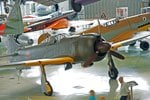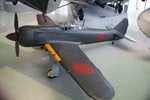Glider
Captain
Gaston
For some reason your links don't work whichis a problem but the ones I have tracked down don't seem to support your statement. The P47 at high speed can turn inside an me109 but at lower speeds it cannot. That is supported by the test flown.
However your claims were very clear, let me repeat them
a) Every Spitfire Mk IX and later combat report shows the Spitfire to avoid sustained low-speed turning like the plague
There is nothing to support this. So what if a Hurricane turns better than a spit presumably a Spit I or II. No quote you an show says that a Spit avoided a turning contest with any german fighter at any height.
b) You claim that the Russians changed their tactics because of the inability of the Spit in a turning contest.
I notice that you hve put nothing together to support this statement either.
Re a low level combat in a Spit IX
S/Lt. R. Gouby of 340 (F.F.) Squadron recorded in his Combat Report for 20 January 1943:
This combat atarted at 1,000ft
The dogfight lasted two or three minutes and two of the FW's broke away and rejoined the formation, but I found myself head-on to the third one who seemed to be the leader. He came straight at me from about 800 yds. and I opened up with cannon and m/g at 600 yds. He began firing too, and I felt a slight shock and guessed I had been hit. I continued to fire but he stopped when about 200 yds. away. I saw pieces fly off his port wing and perhaps the engine cowling and his engine caught fire.
2/Ltn. H. Grundt-Spang of 331 (N) Squadron recorded in his Combat Report for 22 January 1943 height not mentioned but he saw it go into the sea 2,000 yards away, unlikely if he was at 20,000+ ft
The other Hun broke to the left in a steep turn which I had no difficulty at all to follow and gave him all the ammunition with 75 M.P.H. deflection. Then Hun had an explosion in the cockpit and he rolled over on his back and straight into the sea. I looked around for the other a/c and saw it spin into the sea about 2,000 yds. away.
F/Lt. P. F. Kennard of 340 (F.F.) Squadron recorded in his Combat Report for 9 March 1943:
A dogfight at full throttle then ensued with the two FW 190's, lasting about 10 minutes. I had to hold the stick with both hands to keep control. I released my hood at 100 ft. above the sea, thinking I might have to get out quickly. I did a series of tight turns and at least five times was forced over on my back, when I relaxed my pressure on the stick.
I kept looking round every few seconds to keep a careful watch on the two E/A who were never far away, but suddenly I noticed that one had disappeared. We were flying at less than 100 ft. at the time and I saw a big oily patch on the water, so it seems certain that the E/A went in, and I claim this also destroyed.
I then tried to climb a bit. The last FW 190 came so close at one moment that I saw the pilot's features very clearly. I cannot remember what I did exactly, but at about 2000 ft. I saw the FW 190 right below me and slightly in front. I pushed the stick and fired a short burst. I saw a piece fly off his left wing and smoke come from his engine, then he disappeared below me. Turning again, I saw him diving gently away, still pouring out brown smoke. I then flew westwards for home, climbing as much as I could.
As a result of the above action, which took place a few miles off Calais, I claim two FW 190's destroyed and another damaged.
F/Sgt. A. Haynes of 611 Squadron was pleased with the Spitfire LF IX's (Merlin 66) that the Squadron had received in March noting in his Combat Report for 9 April, 1943:
They turned left and I was unable to get deflection because I was turning too fast. There was black smoke coming from both E/A but the No. 2 was belching quite a lot more than the No. 1. The No. 2 then broke downwards and I thought he was going to hit the deck as we were only flying at about 1000-1500 feet - I fired 2 long bursts using all my ammunition. I then turned to come out over Ambleteuse, the flak was very heavy and I collected one small hole in the starboard wing. Just as I got out of the flak I was chased by 3 FW 190's. I dropped the jettison tank but they still seemed to close so I turned towards them and in one turn was on their tail but I continued turning and made for home at full throttle and although they still chased me they could not close - these are good aircraft. I claim 1 FW 190 damaged
I would be interested in the full wording of your favourite quote. Any Hurricane was inferior to an Me109, against a FW it really was in serious trouble. The idea that a hurricane was better against a FW than a Spit I frankly find difficult to believe
For some reason your links don't work whichis a problem but the ones I have tracked down don't seem to support your statement. The P47 at high speed can turn inside an me109 but at lower speeds it cannot. That is supported by the test flown.
However your claims were very clear, let me repeat them
a) Every Spitfire Mk IX and later combat report shows the Spitfire to avoid sustained low-speed turning like the plague
There is nothing to support this. So what if a Hurricane turns better than a spit presumably a Spit I or II. No quote you an show says that a Spit avoided a turning contest with any german fighter at any height.
b) You claim that the Russians changed their tactics because of the inability of the Spit in a turning contest.
I notice that you hve put nothing together to support this statement either.
Re a low level combat in a Spit IX
S/Lt. R. Gouby of 340 (F.F.) Squadron recorded in his Combat Report for 20 January 1943:
This combat atarted at 1,000ft
The dogfight lasted two or three minutes and two of the FW's broke away and rejoined the formation, but I found myself head-on to the third one who seemed to be the leader. He came straight at me from about 800 yds. and I opened up with cannon and m/g at 600 yds. He began firing too, and I felt a slight shock and guessed I had been hit. I continued to fire but he stopped when about 200 yds. away. I saw pieces fly off his port wing and perhaps the engine cowling and his engine caught fire.
2/Ltn. H. Grundt-Spang of 331 (N) Squadron recorded in his Combat Report for 22 January 1943 height not mentioned but he saw it go into the sea 2,000 yards away, unlikely if he was at 20,000+ ft
The other Hun broke to the left in a steep turn which I had no difficulty at all to follow and gave him all the ammunition with 75 M.P.H. deflection. Then Hun had an explosion in the cockpit and he rolled over on his back and straight into the sea. I looked around for the other a/c and saw it spin into the sea about 2,000 yds. away.
F/Lt. P. F. Kennard of 340 (F.F.) Squadron recorded in his Combat Report for 9 March 1943:
A dogfight at full throttle then ensued with the two FW 190's, lasting about 10 minutes. I had to hold the stick with both hands to keep control. I released my hood at 100 ft. above the sea, thinking I might have to get out quickly. I did a series of tight turns and at least five times was forced over on my back, when I relaxed my pressure on the stick.
I kept looking round every few seconds to keep a careful watch on the two E/A who were never far away, but suddenly I noticed that one had disappeared. We were flying at less than 100 ft. at the time and I saw a big oily patch on the water, so it seems certain that the E/A went in, and I claim this also destroyed.
I then tried to climb a bit. The last FW 190 came so close at one moment that I saw the pilot's features very clearly. I cannot remember what I did exactly, but at about 2000 ft. I saw the FW 190 right below me and slightly in front. I pushed the stick and fired a short burst. I saw a piece fly off his left wing and smoke come from his engine, then he disappeared below me. Turning again, I saw him diving gently away, still pouring out brown smoke. I then flew westwards for home, climbing as much as I could.
As a result of the above action, which took place a few miles off Calais, I claim two FW 190's destroyed and another damaged.
F/Sgt. A. Haynes of 611 Squadron was pleased with the Spitfire LF IX's (Merlin 66) that the Squadron had received in March noting in his Combat Report for 9 April, 1943:
They turned left and I was unable to get deflection because I was turning too fast. There was black smoke coming from both E/A but the No. 2 was belching quite a lot more than the No. 1. The No. 2 then broke downwards and I thought he was going to hit the deck as we were only flying at about 1000-1500 feet - I fired 2 long bursts using all my ammunition. I then turned to come out over Ambleteuse, the flak was very heavy and I collected one small hole in the starboard wing. Just as I got out of the flak I was chased by 3 FW 190's. I dropped the jettison tank but they still seemed to close so I turned towards them and in one turn was on their tail but I continued turning and made for home at full throttle and although they still chased me they could not close - these are good aircraft. I claim 1 FW 190 damaged
I would be interested in the full wording of your favourite quote. Any Hurricane was inferior to an Me109, against a FW it really was in serious trouble. The idea that a hurricane was better against a FW than a Spit I frankly find difficult to believe
Last edited:


